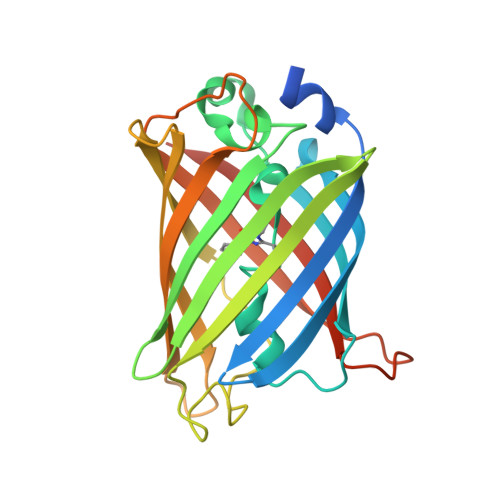Role of Gln222 in Photoswitching of Aequorea Fluorescent Proteins: A Twisting and H-Bonding Affair?
Storti, B., Margheritis, E., Abbandonato, G., Domenichini, G., Dreier, J., Testa, I., Garau, G., Nifosi, R., Bizzarri, R.(2018) ACS Chem Biol 13: 2082-2093
- PubMed: 29878744
- DOI: https://doi.org/10.1021/acschembio.8b00267
- Primary Citation of Related Structures:
6FLL - PubMed Abstract:
Reversibly photoswitchable fluorescent proteins (RSFPs) admirably combine the genetic encoding of fluorescence with the ability to repeatedly toggle between a bright and dark state, adding a new temporal dimension to the fluorescence signal. Accordingly, in recent years RSFPs have paved the way to novel applications in cell imaging that rely on their reversible photoswitching, including many super-resolution techniques such as F-PALM, RESOLFT, and SOFI that provide nanoscale pictures of the living matter. Yet many RSFPs have been engineered by a rational approach only to a limited extent, in the absence of clear structure-property relationships that in most cases make anecdotic the emergence of the photoswitching. We reported [ Bizzarri et al. J. Am Chem Soc. 2010 , 102 , 85 ] how the E222Q replacement is a single photoswitching mutation, since it restores the intrinsic cis-trans photoisomerization properties of the chromophore in otherwise nonswitchable Aequorea proteins of different color and mutation pattern (Q-RSFPs). We here investigate the subtle role of Q222 on the excited-state photophysics of the two simplest Q-RSFPs by a combined experimental and theoretical approach, using their nonswitchable anacestor EGFP as benchmark. Our findings link indissolubly photoswitching and Q222 presence, by a simple yet elegant scenario: largely twisted chromophore structures around the double bond (including hula-twist configurations) are uniquely stabilized by Q222 via H-bonds. Likely, these H-bonds subtly modulate the electronic properties of the chromophore, enabling the conical intersection that connects the excited cis to ground trans chromophore. Thus, Q222 belongs to a restricted family of single mutations that change dramatically the functional phenotype of a protein. The capability to distinguish quantitatively T65S/E222Q EGFP ("WildQ", wQ) from the spectrally identical EGFP by quantitative Optical Lock-In Detection (qOLID) witnesses the relevance of this mutation for cell imaging.
Organizational Affiliation:
NEST , Scuola Normale Superiore and NANO-CNR , 56127 Pisa , Italy.















